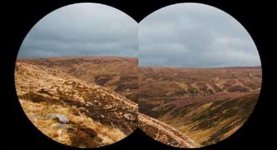Start by comparing specifications and reading reviews, but remember that the only important test is the one that you do when you try out binoculars at the dealers. If you can, go to a dealer that has a view of countryside or park, if you cannot do this go to one with an upstairs and ask to go up there to get a bigger view than just standing in the street outside.
A rough test of binocular collimation (this means checking for the correct alignment of the optics) can be made by looking at a horizontal edge through the binoculars while holding them about 5 cm in front of your eyes, and checking if the edge is the same height on both sides, if the two horizontals do not match (see the image below) then the binocular is faulty and should be rejected. If a landscape horizon is not available, then the edge of a window, or a horizontal bar across a window, can be used for this purpose.
The colour rendition of binoculars can be checked reasonably well with the following test: turn the binoculars around and look through the objective lens at a piece of white paper. In a direct comparison between the paper and the image through the binoculars you can see whether the binoculars have added any undesirable colour (e.g. yellowish tint) relatively quickly. If the image through the objective lens is clearly darker than that of the paper visible from the same viewing angle, it indicates poor light transmission.
In addition you should check to ensure that the eye relief and eyecups of the binocular are suitable for you. If all is well, the circular view through the binoculars should have a perfectly sharp black edge, and there should be no strange dark shapes intruding into the view. Remember to unscrew the eyecups to the top position if you do not wear spectacles, and if you do wear them, the eyecups should be fully screwed down. However, many eyecups today are adjustable to different positions so although you should start from the positions mentioned above, do not be afraid to try the different positions if necessary.
Finally, it is important that your hands feel comfortable supporting the binoculars, and that, from this position, you can comfortably reach the focusing wheel with the finger or fingers you favour for the task of focusing.
A rough test of binocular collimation (this means checking for the correct alignment of the optics) can be made by looking at a horizontal edge through the binoculars while holding them about 5 cm in front of your eyes, and checking if the edge is the same height on both sides, if the two horizontals do not match (see the image below) then the binocular is faulty and should be rejected. If a landscape horizon is not available, then the edge of a window, or a horizontal bar across a window, can be used for this purpose.
The colour rendition of binoculars can be checked reasonably well with the following test: turn the binoculars around and look through the objective lens at a piece of white paper. In a direct comparison between the paper and the image through the binoculars you can see whether the binoculars have added any undesirable colour (e.g. yellowish tint) relatively quickly. If the image through the objective lens is clearly darker than that of the paper visible from the same viewing angle, it indicates poor light transmission.
In addition you should check to ensure that the eye relief and eyecups of the binocular are suitable for you. If all is well, the circular view through the binoculars should have a perfectly sharp black edge, and there should be no strange dark shapes intruding into the view. Remember to unscrew the eyecups to the top position if you do not wear spectacles, and if you do wear them, the eyecups should be fully screwed down. However, many eyecups today are adjustable to different positions so although you should start from the positions mentioned above, do not be afraid to try the different positions if necessary.
Finally, it is important that your hands feel comfortable supporting the binoculars, and that, from this position, you can comfortably reach the focusing wheel with the finger or fingers you favour for the task of focusing.




